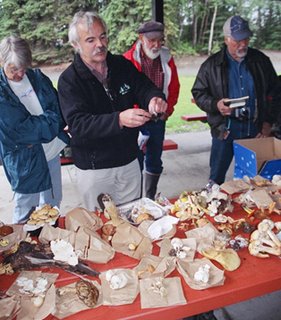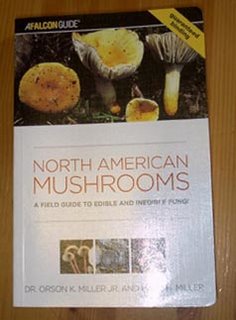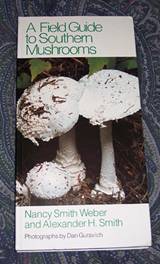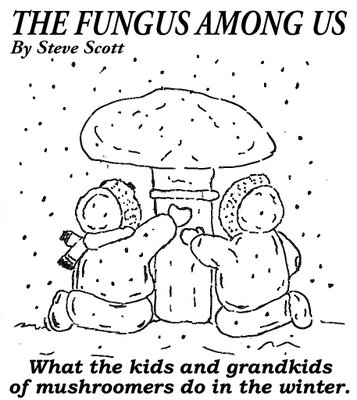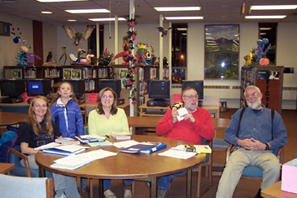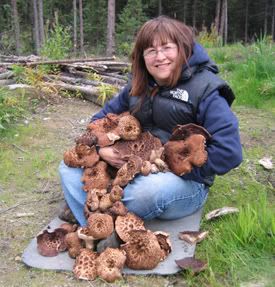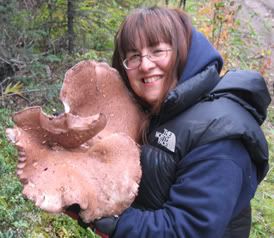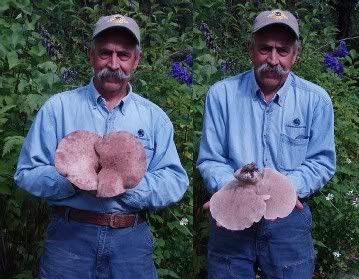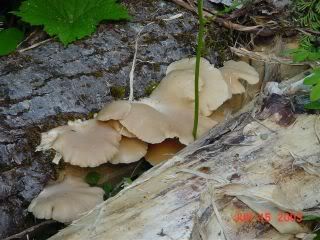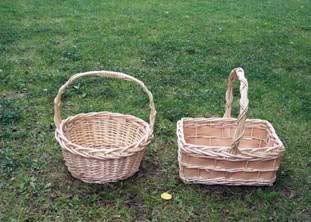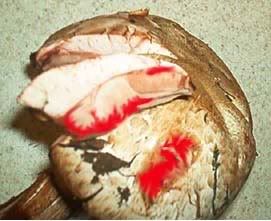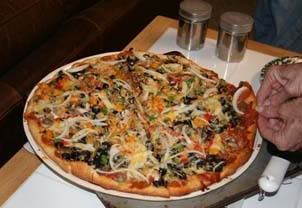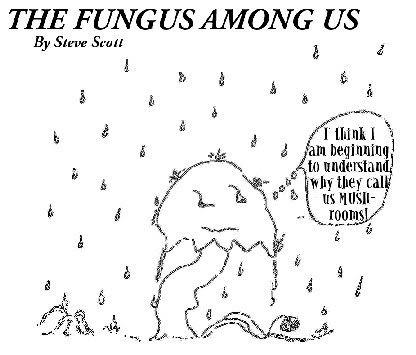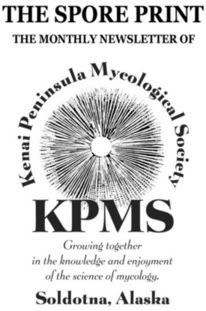Here it is, September already. I am reminded of a quote I read recently, “There comes a time when autumn asks, ‘What have you been doing all summer?’” I’d be tempted to say “What summer?”, but, like most Alaskans, I could look autumn straight in the eye and say “I have tried my best not to waste a single moment of it.”
Both the fishing and the mushrooming started off slow this year. The reds were late, but they closed out the run with a bang (triple the numbers that were forecast). Mushrooming started out much the same, but now, with the abundant rain we have received the last two weeks, it could well turn into a banner year.
Our club foray in Seward produced little in the way of fungal fare, but was a good time, nonetheless. Before I give you my account, I will let Betty Idleman describe her experience.
Our group gathered at Caine’s Head which is down a well potholed gravel road 2 ½ miles past Seward. We climbed both sides of a gut picking mushrooms which Dominique and Steve identified for us. The lack of mushrooms was very disappointing.
Next we gathered about 10 miles before Seward at a turnout along the road. Here the excursion turned into an expedition. We went down the bank and across a creek that runs alongside the road. Then we clawed, crawled, climbed and pulled on blueberry bushes up the steep, steep hill (mountain) to tromp through the wet brush, pushka, devils club, blueberry bushes, deadfalls and holes.
Of course everything in the Seward area is covered with at least 3 inches of wet moss. Stepping over downed trees, there was usually a hole that was covered with brush on the other side. One downed tree was so huge it had to be sat on, and then swiveled on to get to the other side. Of course all that wet moss meant a wet butt. Others were smaller, but you still had to put your knees on them and swivel because it was too high to straddle. Everyone was huffing and puffing and fell at least once. Finally we reached a spot where we were able to slide down the bank and into the creek and cross back to the road. Most of us slid down the steep hill on our butts holding onto blueberry bushes to keep from going too fast and getting hung up in deadfalls. I had only seen about ten different mushrooms and was sweating so badly I got salt in my eyes!
Betty had a lot more to say, and though it might sound like she was complaining, I think she really did enjoy herself.
I was impressed with her stamina. She handled that hike better than some who were twenty years her junior!
Now, let me fill in some of the gaps. First, I have got to say, I fell in love with the Seward area. That coastal forest habitat is really something else. The lush growth and mosses were such a beautiful sight.
Concerning the ‘expedition’ Dominique took us on, Betty did an excellent job of describing the physical torture Dominique put us through, but she didn’t say anything about the mental torment.
As we waded across that creek on our way to the densely wooded hillside behind it, the first thing that caught my eye was the scores of cleanly picked salmon skeletons lying in the water and on the banks. Then there were the tracks, bear tracks everywhere!
After crossing over the creek, we had to pass through about thirty yards of nearly waist high grass; grass that was criss-crossed with bear trails that were so well traveled that the ground had been churned into mud. At this point Dominique began to yell out ‘hey, bear’ or ‘here, bear,’ I wasn’t quite sure which. Even though two of the group, Betty Idleman and Dave Schickendanz were both packing large caliber handguns, and I was clutching my bear spray so tightly my knuckles had turned white, I still felt a twinge of regret for not having the good sense to stay on the other side of the creek.
As we climbed the hill into the thick woods I noticed two things: the huckleberry bushes were picked nearly clean and there were piles of bear poo everywhere. Some of those piles could easily have filled one of those five-quart ice cream buckets. And Dominique was still calling out ‘hey bear’ or ‘here bear!’ I could see we had a dilemma. On the one hand, I wasn’t really sure we wanted to advertise our presence, but on the other, I instinctively knew I didn’t want to stumble onto a sleeping brown; something we could have easily done in that dense undergrowth. The one thing I did know for sure was that I wanted to stay close to the group.
Not being a native Alaskan, I had no idea that I needed a rain suit for a short hike through the woods. When we finally got back to the creek, it didn’t take any urging to get me to slide down the bank and into the knee deep water. Why should it, I was already soaked all the way up to my armpits. And if this was not torment enough, I hadn’t found a single mushroom! Well, so much for Seward.
(Actually, I really did have a good time, but don’t tell Dominique. And by the way, I went out the next day and bought rain bibs and a jacket.)
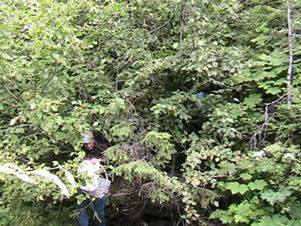
You are probably looking at this photo and saying, ‘what is this suppose to be?’ This is the stuff Dominique took us through. Believe it or not, there is a string of at least a half-dozen people not more than fifteen or twenty feet behind the one you can see!
_______________________________________________Then we had the little impromptu gathering at the Soldotna Creek Park.
The weather was miserable and had been for several days. If it hadn’t been for a handful of hardy souls who had committed to come, I would have been tempted to call the whole thing off. Boy was I surprised when I pulled into the park! A fair number of the folks had arrived before me and two of the tables under the covered picnic area were nearly covered with mushrooms! They had to have been out picking in the rain to come up with so many specimens. This was only the beginning of what would be a great evening!
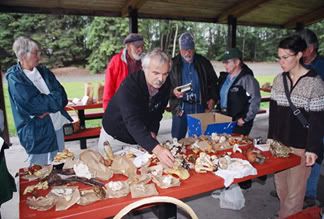
I had thrown in my little two-burner propane stove, and Dominique had brought along cooking supplies. Someone in the group had thought to bring paper plates and plastic silverware. There were a couple of bottles of homemade wine (blackberry and fireweed) and a huge tub of potato salad. So, after we had our harvest identified, we cooked up the edible ones for all to sample. I kept an eye on the obituaries in the Clarion over the next few days and didn’t see any names I recognized, so I guess everyone survived!
Here is an interesting bit of trivia. A number of mushroom clubs throw a banquet for their members at the end of the mushrooming season. Of course, all the dishes contain mushrooms which these members have collected and preserved in anticipation of this feast. This banquet has almost universally become known as the ‘Survivor’s Banquet.’
So what edible species did we collect? This is only a partial list dredged up from my memory, but some of the edible species collected were Armillaria mellea, Boletus edulis, Bovista plumbea, Flammulina velutipes, Laccaria laccata, Lactarius deliciosus, Lycoperdon perlatum, Lycoperdon pyriforme and Russula claroflava.
_______________________________________
I am sure many of you read and enjoyed the ‘mushrooming’ article that appeared in the Peninsula Clarion. The article was written by Patrice Kohl. She was at the Soldotna Creek Park gathering, but I first met her through my daughter at the Skilak Lake foray. I knew she worked at the Clarion, but had no idea she was a reporter. The front page article in the paper the following Thursday came as quite a surprise. Not only did Patrice do a great job, but KPMS got some positive community exposure. Thanks Patrice.
_______________________________________
I would like to thank all those who submitted photos for this issue of the Spore Print. There was a great response and I received a number of excellent photos. Unfortunately, with so little space, I couldn’t use them all.
OUR NEXT FORAY WILL BE SATURDAY, SEPTEMBER 2ND. WE WILL MEET AT 9:00 A.M. AT SOLDOTNA CREEK PARK. FROM THERE, WE WILL BREAK UP INTO GROUPS, COLLECT MUSHROOMS UNTIL 12 NOON, THEN RETURN TO THE PARK FOR AN IDENTIFICATION AND DISCUSSION TIME.
_______________________________________
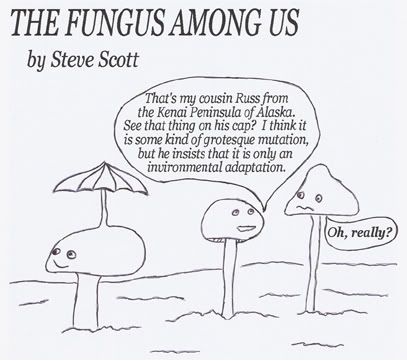
_______________________________________
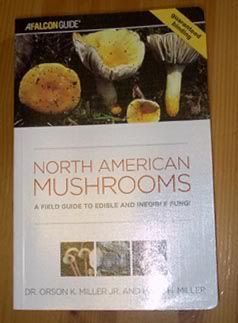
We still have a number of copies of Orson Miller’s North American Mushrooms, A Field Guide to Edible And Inedible Fungi, a few copies of Arora’s Mushroom’s Demystified, and a one copy of All That the Rain Promises and More available. As always, member prices are half of the retail price plus our shipping costs. This is a real deal and a great opportunity to build up your reference library.
_______________________________________
There are a number of great educational opportunities available through the local Community Schools program this fall. Here is one entry from the brochure.
BEGINNING MUSHROOMING – Acquiring the basic skills necessary to identify mushrooms.
Steve Scott. This is a non-technical course designed to equip the amateur mushroom hunter with the skills necessary to confidently identify their fungal finds using only macroscopic features. The course will also include an overview of the fungal kingdom and a discussion on mushroom toxins. Tuesdays AND Thursdays, beginning October 3rd and ending October 19th / 6 nights / 7-9pm / Teens and Adults / 6 Min and 12 Max / $15 that goes to Community Schools (Study materials will be provided.)
_______________________________________
August’s ‘Mushroom of the Month’ Photo
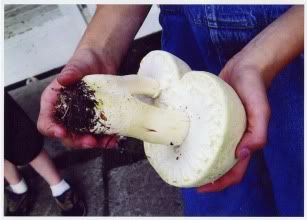
The picture above was the August ‘Mushroom of the Month,’ Agaricus arvensis. This species is easily identified by its chocolate brown spore print, anise odor, habit of growing in grassy areas, and the cogwheel pattern produced in the unbroken veil as the cap expands.
For the second straight month, the ‘Mushroom of the Month’ went unidentified and our prize unclaimed. We did not receive a single response. It may be that our prize (your name and achievement immortalized in our newsletter) was not enticing enough. This month we have upped the ante. If you are the first to respond with the correct answer, you will receive a beautiful mushroom picking basket courtesy of KPMS!
The September Mushroom of the Month
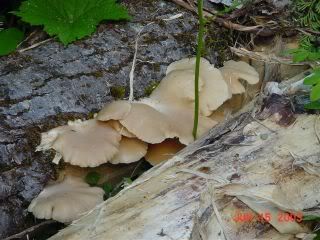
This edible species is easily distinguished by its pleasant, fruity odor, lilac to lilac-gray spore print, lack of a stipe, off-center attachment, and habit of growing on dead hardwoods (especially cottonwoods).
_____________________________________ There were a number of inquiries concerning our absence at the fair. I am not sure just what happened, but somehow we dropped the ball and failed to reserve a booth before the registration deadline.
With all of this rain, I am expecting a great foray on September 2nd. And, if the rain continues until then we should see a number of boletes like the one below. Unfortunately, the moose had been chewing on it, but it was free of maggots!
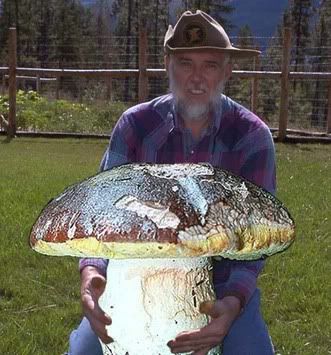
I’m only kidding, but don’t you wish they got this large?
I have included a couple of short reminders at the end of this newsletter. The first is a list of the proper steps to take when collecting mushrooms, and the second (if you plan on eating any of the specimens you have collected) is a list of the precautions you should be taking to avoid mushroom poisoning. I would like to credit the original authors, but haven’t a clue who they were. I suspect that these lists have been in circulation so long, and revised so many times that the original penmen would not even recognize them. But, isn’t that the way it often is with good advice?
I hope to see you at the foray. Until then I will leave you with this wise caution I once heard from an old, old ‘shroomer, “there are old mushroomers and there are bold mushroomers, but there are no old, bold mushroomers.” See you on the 2nd,
Steve
KPMS Contact information:
Steve Scott, President sscott@alaska.net
Dominique Collet, Vice-President gastrancitrus@yahoo.com
Janice Chumley, Secretary-Treasurer weraftalaska@gci.net
_____________________________________
THE PROPER STEPS TO
MUSHROOM COLLECTION AND IDENTIFICATION
1. Carefully collect the complete fruiting body (both above and below ground level). A deadly Amanita species could easily be confused with an edible young Agaricus or a Lepiota if the Amanita’s stipe is cut or broken off. Whenever possible, gather specimens in various stages of development.
2. Specimens should be carefully cleaned. A sharp knife and soft brush are important additions to your gathering basket. Do not mix species. Carry small paper bags or wax paper to wrap and separate your collection.
3. Note the habitat in which you find your specimen. Tree associations, amount of direct light, aspect, substrate etc. are all clues that will aid you in identifying your mushroom. Make copies of the ‘COLLECTION AND IDENTIFICATION RECORD’ available through KPMS and use them. It is an extremely useful tool.
4. Take a spore print as soon as possible. Without a spore print your ‘identification’ is little more than a guess! Spore prints are obtained by cutting the stem of a mushroom flush with the cap and placing the cap ‘gill side’ down on white paper. On the ‘COLLECTION AND IDENTIFICATION RECORD’ there is an oval containing both a black and a white surface. This will give a truer color than a single background. With older specimens, covering the cap with a moist paper towel will often encourage a ‘tired’ mushroom to release additional spores. When attempting to obtain a print from a bolete or a wet, ‘gilled’ specimen elevate the cap slightly off the paper with toothpicks. The results will be much better and the color truer.
5. Learn to use identification keys. Any good field guide will include identification keys. MUSHROOMS DEMYSTIFIED has excellent ones. The MATCHMAKER CD is another excellent method of ‘keying’ out your specimen. Do not rely on a picture in a field guide for your identification. Again, do not rely on a picture in a field guide for your identification. And again, do not rely on a picture in a field guide for your identification. Even good photos are far, far inferior to a key. (It should be noted that not all specimens will ‘key out’, nor does any field guide contain every species (especially those that are uncommon).
6. Whenever possible, confirm your identification with an experienced mushroomer.
If you will follow the suggestions above and learn to use the identification keys effectively, you will quickly become proficient in identifying mushrooms to genus and species. But, there are no shortcuts. Proficiency comes with patience and study.
ENJOYING MUSHROOMS WITHOUT BEING POISONED
The fact that many mushrooms are edible is undoubtedly the reason most are attracted to the hobby. And, for those of us who enjoy wild mushrooms, this continues to be an area of interest. But, not all mushroom species are edible, and the fact that a mushroom is considered edible does not mean that some individuals will not find it toxic to them. We do not encourage anyone to eat wild mushrooms, but if you chose to do so, the following cautions should be carefully followed.
1. Learn to recognize a few species that are easy to identify and have no ‘look-alikes,’ and eat only those. Leave all of the rest alone (enjoying them for their beauty only).
2. Examine and identify each specimen. A poisonous ‘look-alike’ may be mixed in. Do not eat any mushroom that you have not positively (without any question or doubt) identified. (The old sayings, ‘when in doubt, throw it out,’ and ‘there are old mushroomers and bold mushroomers, but no old, bold mushroomers’ are words of wisdom.)
3. Keep specimens you plan to eat separate from any others you may have collected.
4. Always cook wild mushrooms. Most edible species contain toxins that are destroyed in the cooking process. Cooking also makes the complex proteins more digestible.
5. Save out a few specimens from each batch that you plan to consume. These are for identification purposes in case you do get sick.
6. Eat only fresh mushrooms. Refrigerate and eat or preserve immediately. Spoiled mushrooms will make you sick, just as any spoiled food will.
7. Eat only a small amount of a ‘new’ kind the first time. Body chemistries differ, and not all individuals are able to eat every ‘edible’ mushroom species.
8. Do not gather mushrooms for the table from any area where pesticides, herbicides or chemical fertilizers have been used. Mushrooms are ‘decomposers’ and will concentrate chemical residues. Areas such as city parks, lawns around public buildings and schools, road right-of-ways etc. are particularly hazardous. NAMA (North American Mycological Association) has kept thorough records of mushroom poisonings for a number of years and has verified a number of instances where edible mushrooms caused serious poisonings because of chemical contamination.
9. Limit or abstain from alcohol consumption or anti-depressant drugs when you eat wild mushrooms.
10. Do not serve wild mushrooms to small children or those that are weak or chronically ill.
Although fatalities from mushroom consumption are actually quite rare, there are a number of species which will cause severe gastro-intestinal illness. Mycophagy (the eating of mushrooms), can be enjoyable, but it demands the utmost care and caution.













